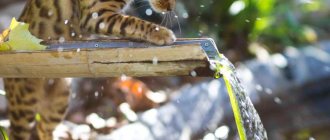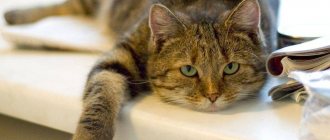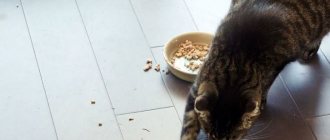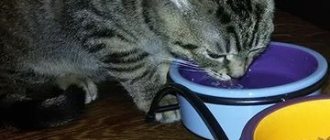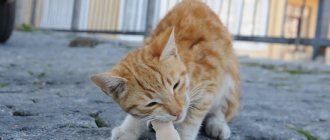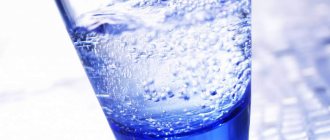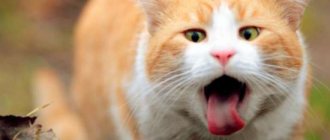10140Administration
3
Without water, warm-blooded animals have no life. Why doesn't the cat drink water? The reasons can be varied: health status, personality traits, diet, illness. This animal behavior cannot be ignored. Before taking any measures, the owner must understand the reason why the cat refuses or drinks little water. It is necessary to analyze her behavior, find out how much water she should drink and how much she actually drinks.
The cat refuses water completely
Sometimes a perfectly healthy cat does not want to drink water. Why is this happening?
Check the temperature of the water in the bowl. Cats - unlike people - do not like cold water and are much more willing to drink water that is at room temperature.
If you switched your cat from dry food to wet food, this may cause her to refuse water: she began to receive the required amount of liquid with food and began to drink much less often.
It has been noticed: in the summer, in extreme heat, all cats become real water-drinkers. With the arrival of autumn, especially during the cool and damp period before the start of the heating season, the need for drinking in cats decreases significantly.
But it also happens that a cat, along with refusing water, begins to show anxiety, looks depressed and clearly sick, cries and tries to hide in a secluded corner. These are clear signs of ill health. If, in addition, your cat is vomiting and has an upset stomach, you should immediately take her to the vet.
Water requirements
Now let’s summarize the above and supplement the information with some interesting points. Of course, there are certain requirements for water. Although some cats still surprise us by the fact that they can drink dirty water on the street, or even climb into the toilet. If you notice similar behavior in an animal, try to be patient to retrain it. In fact, water is very important for the health of an animal's body. Of course, sometimes it’s very difficult to teach an animal to drink. If you still can't get your cat used to water, try our other tips. We reviewed them above.
We also recommend that you consider the following points:
- Temperature of the liquid in the bowl. In nature, wild cats are accustomed to drinking water from streams or other sources. Of course, such predators are more adapted to survival conditions. At home you should give water at room temperature. It is important to know that sometimes animals can have throat problems;
- Purity. Tap water may not always be suitable. Moreover, in different regions its quality may vary significantly. Even a person can feel chlorine impurities. And what can we say then about pesticides, metals and sedimentary material? Of course, drinking water from the tap can help build immunity. But also take into account how clean the water is in your area and whether it is suitable for drinking;
- Foreign odors. A cat will not drink water from a bowl if it contains aromas that are unpleasant to its receptors. For example, chemicals or the smell of the bowl itself, well-washed food debris or stagnant water. Therefore, pay attention to cleanliness and the washing process;
- How often to change. Make sure that the water does not stagnate for a long time and is not dirty during the day. Change it once a day, sometimes more often.
Doesn't drink or go to the toilet
If you find that your pet is not touching water or using the litter box, this could be a sign of urolithiasis or kidney inflammation. In any case, the animal must be examined by a doctor and appropriate treatment prescribed.
Sometimes this can happen due to extreme stress. Cats that had to urgently leave their home with their owners and stay in an unfamiliar place for a long time, with a large crowd of people, may not drink and, accordingly, not go to the litter box for 2-3 days. As soon as the animal finds itself in a calm environment, its condition should normalize on its own.
Fluid norm for caudates
Only a small number of owners know the daily fluid intake for their pet. Despite this, this indicator is very important and is calculated individually based on a number of criteria.
Volume by mass and activity
On average, the recommended volume is 20-40 ml per 1 kg of weight for adult animals (that is, a 5-kilogram cat will drink about 150 ml, that is, half a glass). For kittens, these numbers increase 2-3 times.
In addition to age and body weight, activity level affects the final value. The norm of mustachioed couch potatoes is lower than that of energetic lovers of regular walks on the street and frequent runs around the house.
Exceeding the norm is permissible within 15-20% of the total volume. If your pet drinks more, there is every reason to suspect something is wrong.
How to determine how much water your pet drinks
The easiest way is to use a measuring cup. Fill it to the full mark and pour the contents into a bowl. At the end of the day, pour the rest back into the glass and compare it with what you had. The resulting difference is the desired value.
If there are several cats, they will have to be temporarily isolated from each other. Otherwise, the experiment will not be indicative. To increase reliability, take several measurements on different days and calculate the arithmetic average.
Doesn't drink from a bowl
If your pussy won't go to its water bowl, but it feels good and looks completely healthy, first try to determine if it has found a more attractive place for a "watering hole." This could be an open aquarium, a tray for a flower pot (some types of indoor plants prefer to always have water in the tray), a leaking faucet from which it is very interesting to lick the flowing droplets, a puddle in the yard or even a toilet hole...
Check the water bowl. How long has it been since you washed it? Ideally, this should be done every day. Or maybe the old bowl broke and you replaced it with a new one? The cat may not like your choice.
Is milk acceptable in the diet of an adult cat - benefit or harm?
Veterinarians and nutritionists advise excluding milk from a cat’s diet from 6 months, and some experts suggest doing this earlier - as early as 4 months.
This is due to the fact that this product contains a special element in huge concentration - milk sugar. Its breakdown is carried out in the cat's body under the influence of the enzyme lactose.
The body of any mammal produces quite a lot of it in infancy and childhood and produces practically none at all in adulthood.
This theory is confirmed by almost all experts - product rejection occurs in most individuals, but there are exceptions to the rule.
Some adult and even elderly pets happily drink milk without any consequences for the proper functioning of the body. This is due to the individual characteristics of specific individuals. This means that it is in their body that a lot of lactose is still produced and the breakdown of milk sugars occurs successfully.
All adult animals like the taste of milk, but numerous studies have confirmed that it does not bring any benefit to the pet. Some cats, even in the absence of dyspeptic symptoms, may develop an allergic reaction when feeding them milk.
Thus, despite the assertion of some scientists about the indispensability of cow's milk in the diet of cats, most experts recognize this product as harmful and unacceptable in the diet of adult pets:
- The high calorie content of milk can lead to imbalance in the body and ultimately lead to obesity.
- The high content of casein and lactose does not allow the product to be completely absorbed.
- An extremely high concentration of elements that are unacceptable in the diet of an adult animal contributes to the development of allergies.
- Intolerance to milk sugars by the cat's body leads to indigestion, flatulence, bloating, indigestion, chronic diarrhea and dehydration.
Doesn't drink or eat
When a young kitty suddenly refuses food and water and appears confused and lethargic, calculate how many months she is before running to the vet. Perhaps your pet has entered her first heat and is trying to get used to new sensations.
Another common reason for refusing water and food is worms. After taking the anthelmintic drug, your pet will regain good health and interest in life.
If, in addition, the cat has diarrhea, these are clear signs of a disease of the stomach, liver or pancreas. Only treatment and a change in diet can help here.
Sometimes a complete refusal of food and water is a serious sign of a disease of the blood, respiratory tract or reproductive organs.
In any case, take your pet to the vet. Even if it's just the whims of the cat. You will be sure that she is healthy, and with the help of a specialist you will be able to restore her to her former appetite.
Dangerous symptoms: when should you see a doctor?
Veterinary care is necessary if the cat hardly drinks water or refuses it at all, and the following signs appear:
An animal becomes seriously ill if it develops a specific discharge from the eyes and nose.
- Temperature increase.
- Anxiety, changes in behavior and taste preferences.
- The cat often sits down to pee and urinates blood.
- Pale and dry mucous membranes.
- Constantly meows in pain.
- Vomiting, diarrhea.
- The appearance of ulcers and bleeding in the mouth.
- Frequent swallowing, the cat makes strained attempts to push something out of the mouth.
- Hoarse nasal breathing, snoring during sleep.
- Discharge from nose and eyes.
- The cat constantly spends time lying down, does not get up, and refuses to play.
- Difficulty breathing or shortness of breath.
- Heart dysfunction.
- Decreased sensitivity of the limbs.
- Stickiness, viscosity of saliva.
- Lack of skin elasticity.
- Dramatic weight loss.
Drinks only milk
Little kittens love and digest milk very well. With age, the picture may change: in an adult cat, whole milk most often causes an upset stomach.
But it also happens that until a very advanced age, a cat drinks only milk, categorically refusing water. If you give him wet food, it is quite possible that the moisture contained in it is enough for the animal to function normally. If he is cheerful and active, examinations at the veterinary clinic do not show any abnormalities, there is nothing to worry about.
However, if for some reason you decide to switch such an animal to dry food, it is better to abandon this idea. If there is a lack of fluid, he may develop urolithiasis.
What are the consequences of lack of fluid?
If an adult cat or small kitten does not eat or drink, the pet can become seriously ill, since dehydration can lead to the following ailments:
Against the background of this condition, blood clots may form in the animal as the blood becomes thicker.
- Urolithiasis disease. Cats have concentrated urine, so if the cat begins to refuse fluid, this leads to the formation of struvite. If stones block the ureters, urine is not excreted from the body. This is dangerous due to uremia and general intoxication, which is dangerously fatal.
- Blood thickening. When a pet doesn't like to drink, it leads to viscosity and poor circulation. The condition increases the load on the heart, reduces the functionality of the liver and kidneys, provokes oxygen starvation of tissues, the formation of blood clots, which ends in death.
- Kidney failure. It occurs in acute and chronic forms. It is characterized by suppression of kidney function, accumulation of harmful substances in the body, and increased blood pressure. The most susceptible to pathology are British, Maine Coon, and Persian cats.
- Dehydration. This is a critical lack of water in the animal’s body, in which all organs and systems suffer. If a pet does not drink for more than 2-3 days, there is a high probability of irreversible changes and death.
Goat and sheep milk
It must be admitted that goat and sheep milk is less allergenic than cow milk. If an adult cat has an intolerance to cow's milk, but you really want to treat it with milk, then this will be a good replacement.
As for kittens, ruminant milk does not cover their nutritional needs. Proteins and fats will not be enough, and, as a result, a kitten fed with goat's or sheep's milk will grow and develop slowly.
The lactose content in the milk of goats and sheep is higher than that of cats. Although kittens produce lactase, it is designed for cat milk.
Symptoms of dehydration
- Sunken or very dry eyes;
- Dry skin or skin with less elasticity. When the skin is pinched, it does not immediately recover;
- Dry mouth.
- Capillary refill time. When pressing on the gums, it takes time for them to restore their red natural color.
- Increased body temperature and increased heart rate;
- Dyspnea.
If you have these symptoms, your pet should be taken to the veterinarian immediately to find out the cause.
The kitten started eating
Any mother is naturally endowed with a wonderful instinct of caring for her offspring. Helpless babies will not survive without a reverent mother's attitude. And if in the human world a mother’s care has no expiration date, then cats are ready to let their little ones go from their hearts after just 3 weeks. In the wild, cubs immediately learn to get their own food, but kittens living in an apartment have to rely on their owner. Inexperienced owners have no idea whether to allow the kitten to eat on its own or what to include in its diet. This baby is so small and fragile that mistakes are unacceptable. So, how to properly organize the independent feeding of a fluffy mustache?
Age-related nuances of the cat’s “table”
Cats allow their children to live independently early, but are ready to provide them with milk for up to 2 months if necessary. Domestic kittens are usually ready for complementary feeding after 3 weeks of life. In addition, the children are growing rapidly, and it is becoming increasingly difficult for the cat mother to feed this horde.
At the age of 1-1.5 months, the kitten should receive warm liquid food 5-6 times a day. The following dishes can be placed on the cat’s “table”:
- baby meat and vegetable puree;
- semolina porridge with milk without sugar;
- mashed boiled yolk (a little);
- low-fat cottage cheese.
By 2 months, when the first baby teeth emerge, feline babies are ready to try solid food. But you shouldn’t exclude liquid food, as it is good for digestion. Don’t forget: the kitten is growing and developing rapidly, and every day its need for nutrients increases. The better nutrition that is “invested” in the baby at this age, the stronger his health will ultimately be. The following products are suitable for the table:
- lean boiled meat;
- children's cottage cheese;
- cereals (oatmeal, buckwheat, rice);
- chicken yolk;
- fermented milk products and milk;
- low-fat cheese without salt;
- natural yoghurts.
By 3 months, the baby can be switched to dry cat food. Don't skimp on your pet's health. Economy class food is often made up at random from meat and bone waste; it will not be able to fully saturate the cat’s body with the necessary substances. It is better to buy super premium kitten food. From the owner's refrigerator, a three-month-old baby will benefit from the following delicacies:
- lean boiled meat, cut into pieces;
- offal (beef heart/liver);
- boiled sea fish;
- fermented milk cuisine;
- grated vegetables and fruits;
- salad of finely chopped greens and olive oil;
- chicken yolk;
- cereals (rice, buckwheat, millet, rolled oats);
- natural yogurt.
To prevent your cat from being capricious in the future, you need to accustom him to the right table from childhood. It is not uncommon for cats to become hooked on a certain type of food and refuse others that are no less healthy. One regular dish cannot contain all the vitamins a cat needs. And if you want your pet to be an omnivore, teach him to eat fruits, vegetables and cereals from early childhood.
Newborn without mother
It happens that for some reason newborn babies are left without breast milk. Then the owner will face a real test, which will take a lot of time and effort, but will save the little cat’s life. The participation of a veterinarian in this feat is mandatory. A specialist will help you choose food and explain all the nuances of replacing cat milk with cow milk.
Up to 3-4 weeks, babies are fed 8 times a day using a pipette. The milk must be warm (but not higher than 37 degrees). If you drop it on the back of your hand, you can determine the temperature. The skin should not be hot. From 1 to 2 months, you can continue to feed the kitten with milk using a pacifier. After feeding, experts recommend gently massaging the cat's belly so that the digestive system works correctly.
The most important thing in feeding newborn kittens is not to overfeed the baby. Excess milk has an extremely detrimental effect on the fragile health of the baby.
In a sense, it is better to underfeed the baby than to risk his condition. The veterinarian will help determine the dosage of food.
